Overview
Successful fitness app development hinges on essential features such as:
- Personalized workout plans
- Gamification
- Real-time data monitoring
- Robust data security measures
These features significantly enhance user engagement and satisfaction, while also addressing critical challenges, including:
- Privacy concerns
- The imperative for continuous improvement through user feedback
By integrating these elements, developers can ensure the app's effectiveness in promoting health and wellness, ultimately establishing a strong foundation for user loyalty and success.
Introduction
The fitness app development landscape is evolving at an unprecedented pace, fueled by a surging demand for personalized health solutions and cutting-edge technology. With the market projected to reach an impressive USD 25.9 billion by 2025, it is imperative for developers to grasp the essential features that drive successful app creation. Yet, amid this wave of innovation, challenges such as regulatory compliance and data privacy present significant hurdles, prompting critical inquiries into how to effectively balance user engagement with security. What key components can propel fitness apps to success while adeptly navigating these complexities?
SDA: Custom Software Development for Fitness Apps
SDA stands at the forefront of custom software development tailored specifically for the sports industry, offering solutions that meet the unique demands of app creators in this dynamic sector. As we look towards 2025, the fitness app development market is projected to soar to USD 25.9 billion, propelled by a surge in health consciousness and technological advancements. This remarkable growth underscores the critical importance of client-focused design, which is essential for crafting engaging and effective applications that enhance individual health and wellness. SDA's dedicated development teams collaborate closely with clients to fully grasp their vision, transforming it into robust applications that elevate user experience and foster business growth.
Nevertheless, creators of wellness applications face significant challenges, including navigating stricter regulatory environments and addressing privacy concerns, both of which can hinder market expansion. Selecting the appropriate tech stack is equally vital, as it profoundly impacts development costs and the capabilities of the app. Successful fitness app development increasingly integrates features such as personalized workout plans, gamification elements, and real-time data monitoring through wearable devices, all of which significantly boost participant engagement. For example, case studies reveal that applications featuring mental health support and community aspects not only enhance user retention but also contribute to overall well-being.
By focusing on these emerging trends and leveraging advanced technology, SDA positions itself as a strategic partner for app developers eager to innovate and thrive in a competitive landscape. To effectively harness consumer-focused design, developers must prioritize user feedback throughout the development process, ensuring that the final product aligns seamlessly with client needs and preferences.
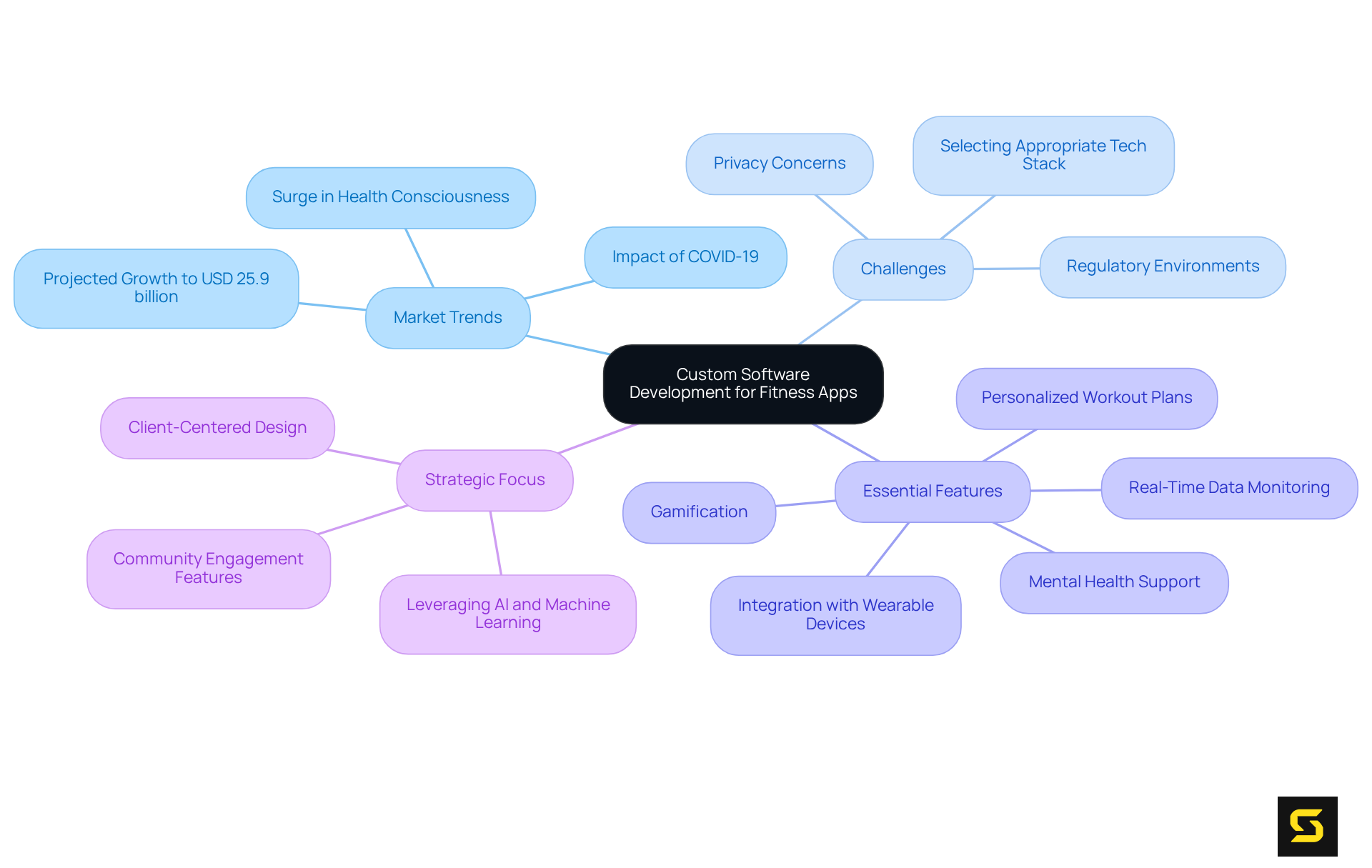
Personalized Workouts: Tailoring Fitness Experiences
Tailored exercise routines are essential for fitness app development, as they address the distinct requirements and preferences of each individual. By utilizing participant data—such as activity levels, objectives, and preferences—fitness app development can enable developers to design customized workout plans that adapt over time. This method not only enhances satisfaction among participants in fitness app development but also encourages steady involvement, as individuals feel their unique wellness journeys are acknowledged and supported.
The integration of AI-driven recommendations in fitness app development significantly amplifies this personalization, making workouts more effective and enjoyable. For instance, AI can evaluate individual performance and preferences, along with information from activity trackers and smartwatches, to recommend optimal exercises, ensuring that each session aligns with the individual's evolving wellness objectives. This degree of personalization has been shown to improve engagement rates, with research suggesting that tailored exercise plans can lead to a 23% increase in retention compared to standard offerings.
Moreover, as fitness app development continues to evolve, it highlights the significance of tailored workouts in achieving specific health goals within the shift towards preventive care in health. The role of AI in developing personalized experiences will be crucial in enhancing satisfaction and long-term commitment to exercise routines.
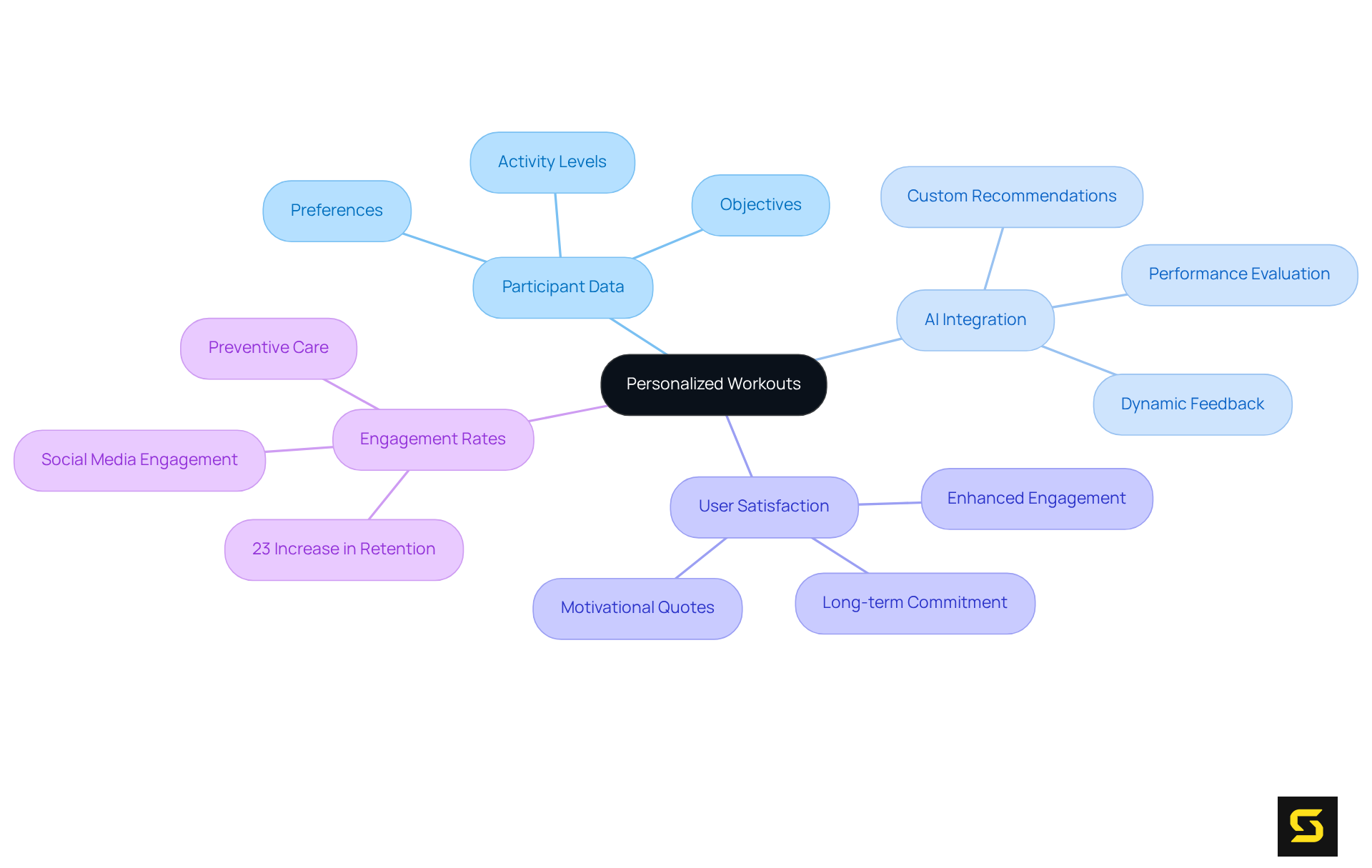
Analytics Integration: Enhancing User Insights
Incorporating analytics into fitness app development empowers developers to effectively track participant behavior, workout patterns, and engagement levels. By examining this data, fitness app development teams can unveil trends and pinpoint areas for improvement, thereby enhancing features that elevate user experience.
For instance, insights into the most popular workouts can steer future content updates, while progress monitoring facilitates personalized recommendations tailored to individual fitness journeys. Notably, platforms such as Strava and MapMyFitness leverage geolocation for precise activity monitoring, which is essential in fitness app development and significantly boosts participant engagement.
This data-driven strategy not only increases user satisfaction but also fosters loyalty, as users observe tangible results from their efforts. With the digital wellness market projected to reach $89.32 billion by 2030 and the global exercise applications market estimated at $12.1 billion in 2024, expanding at a CAGR of 13.5%, fitness app development utilizing analytics is crucial for maintaining competitiveness and addressing the evolving demands of health enthusiasts.
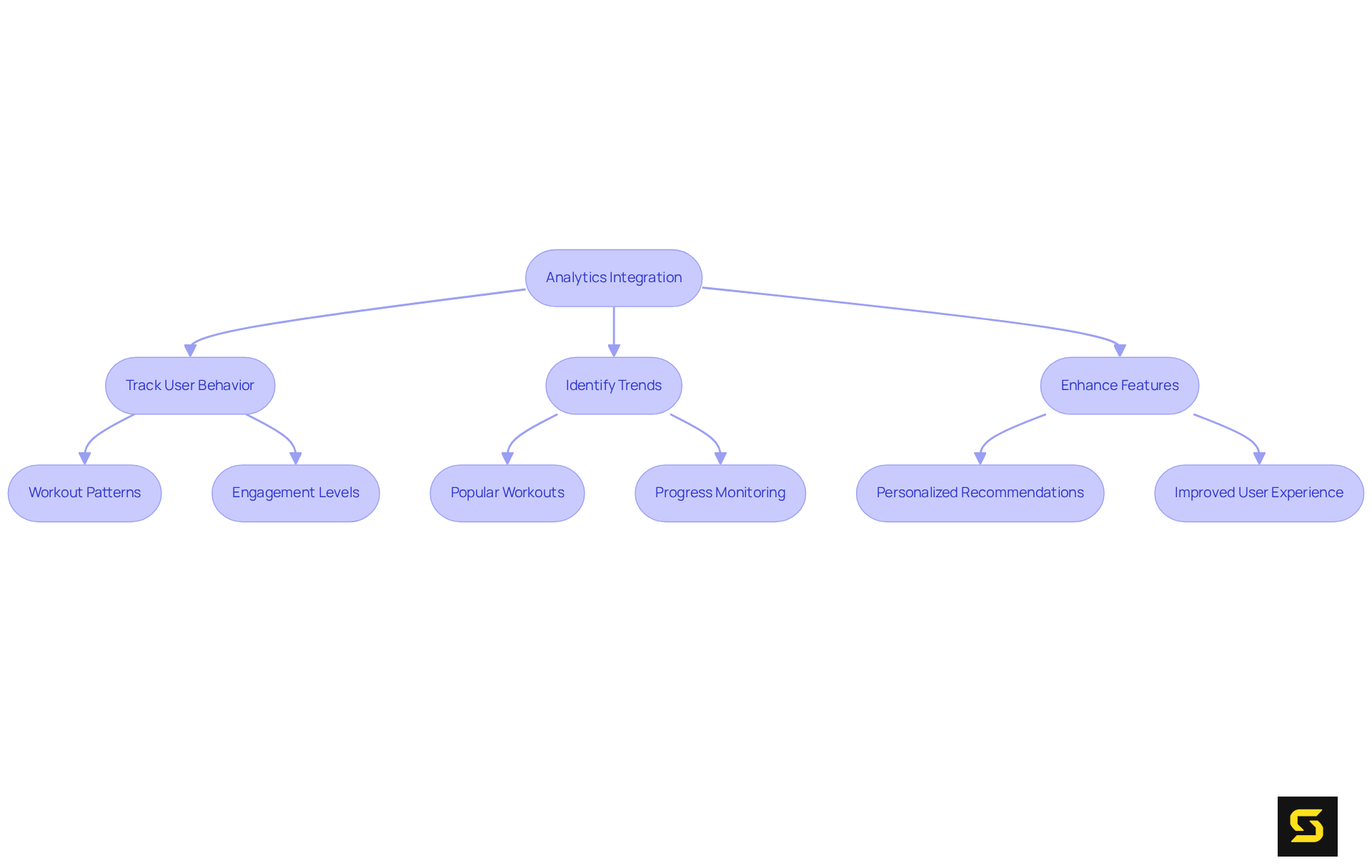
Data Security and Privacy: Building User Trust
In today's landscape, where information breaches are increasingly prevalent, ensuring security and privacy is paramount in fitness app development. By implementing robust encryption techniques, secure client authentication, and transparent information usage policies, developers can foster trust among users.
Adherence to regulations such as GDPR is essential for safeguarding user information and empowering individuals with control over their personal data. Alarmingly, healthcare information breaches have risen consistently over the past 14 years, with 32% of all recorded breaches from 2015 to 2022 occurring within the healthcare sector. The largest data breach of 2023, which impacted 11,270,000 individuals, starkly highlights the severe consequences of insufficient data security.
Prioritizing security not only protects personal information but also enhances the app's reputation, encouraging greater user engagement. This focus on security is particularly critical across various workout platforms, including:
- Exercise and Training Programs
- Nutrition-Tracking Systems
- Activity Monitoring Solutions
Each facing unique security challenges. Therefore, it is imperative for those involved in fitness app development to take decisive action in fortifying their security measures.
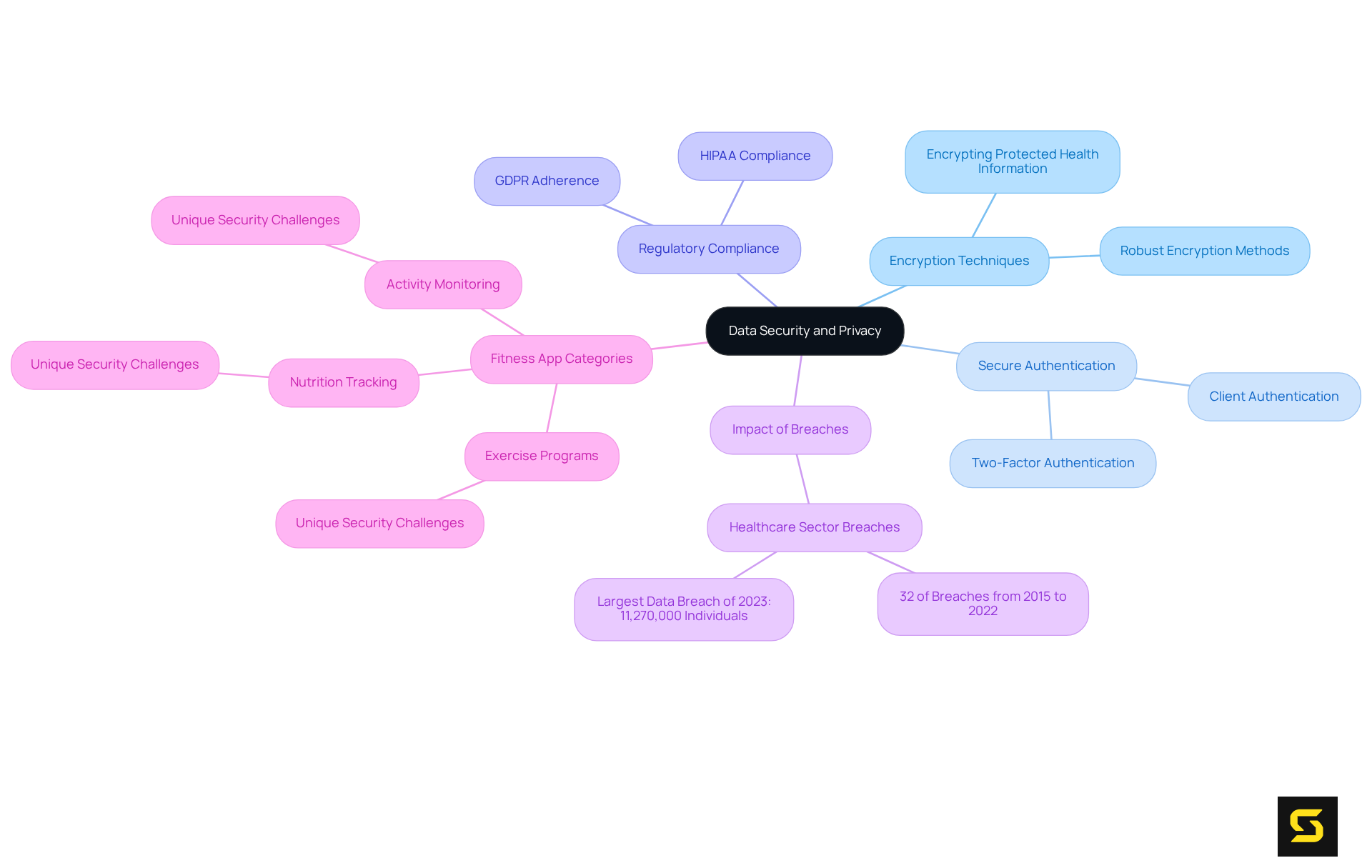
Intuitive User Interface (UI) Design: Ensuring Usability
An intuitive interface (UI) is paramount for facilitating seamless navigation in the context of fitness app development. Key design principles—simplicity, clarity, and responsiveness—are crucial in enhancing user experience. As Scott Belsky asserts, simplicity is vital in UX design; a clear experience is essential for effective navigation and usability. By minimizing clutter and establishing straightforward pathways to access features, developers can significantly enhance usability.
Visual elements, such as progress trackers and motivational prompts, not only sustain user engagement but also foster a positive emotional connection with the app, encouraging consistent usage. Research reveals that applications with well-executed UI design enjoy higher satisfaction rates, directly correlating with increased retention and engagement. Indeed, design-driven companies outperform their competitors by 228% and report 50% more loyal customers, highlighting the substantial business impact of effective UI design.
For instance, successful UI design in exercise applications frequently includes personalized dashboards, allowing users to monitor their progress and set achievable goals, thereby enriching their overall experience. Ultimately, a meticulously crafted UI not only enhances functionality but also cultivates a loyal clientele, making it an indispensable component of successful fitness app development in the health sector.
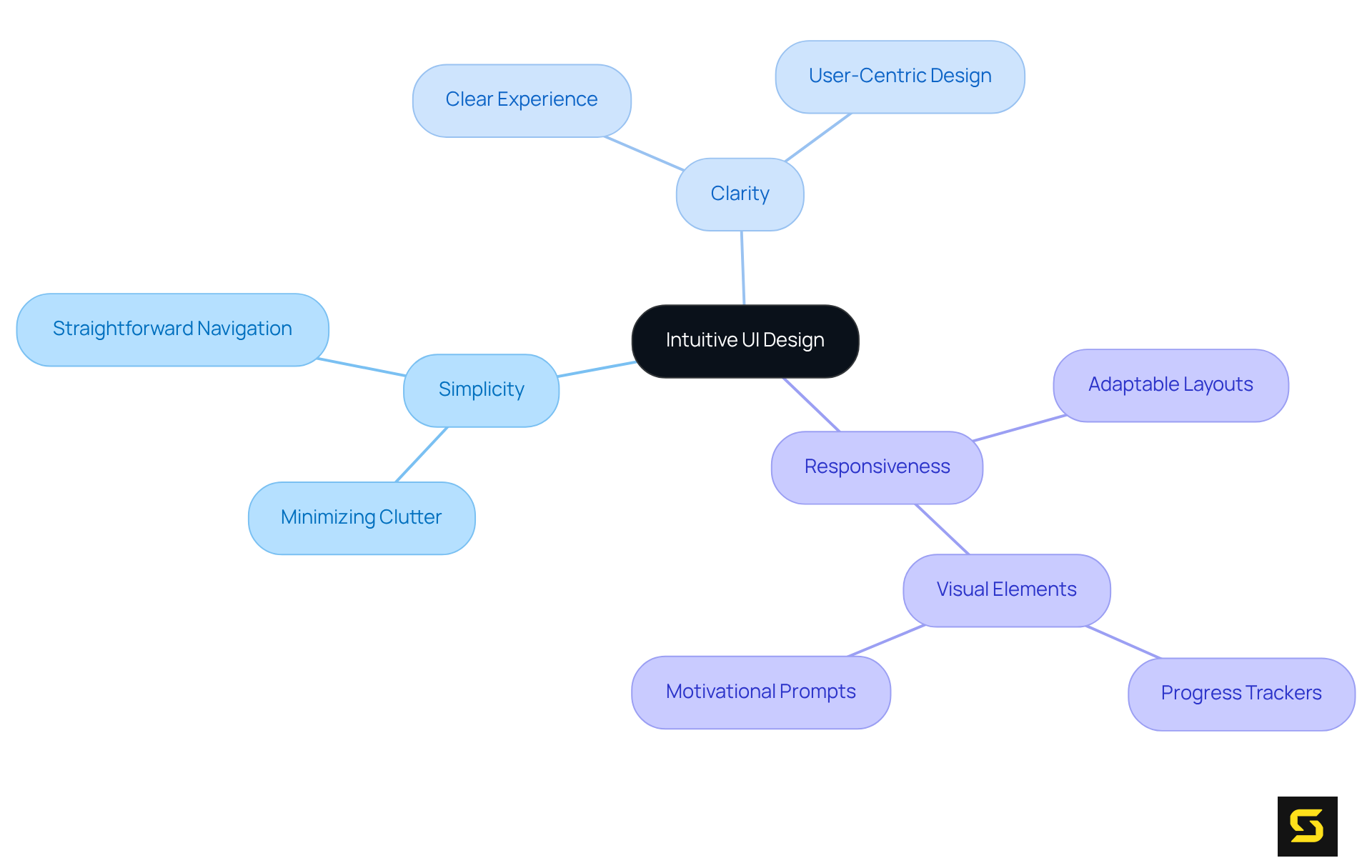
Social Community: Fostering Engagement
Integrating social community elements into fitness app development significantly enhances participant engagement. Fitness app development incorporates features such as forums, challenges, and leaderboards, facilitating connections among participants and enabling them to share progress and motivate each other. This communal aspect fosters a sense of responsibility, as individuals feel supported throughout their wellness journeys.
Research indicates that fitness app development incorporating community features enjoys higher retention rates, with approximately 64.1 million gym members in the U.S. actively seeking social interactions to enrich their wellness experiences. Furthermore, these social elements inspire individuals to invite friends, thereby expanding the app's audience and cultivating a vibrant, engaging environment that encourages participants to return consistently.
Engaging in a community not only amplifies motivation but also transforms physical well-being into a collective experience, making the journey more enjoyable and sustainable.
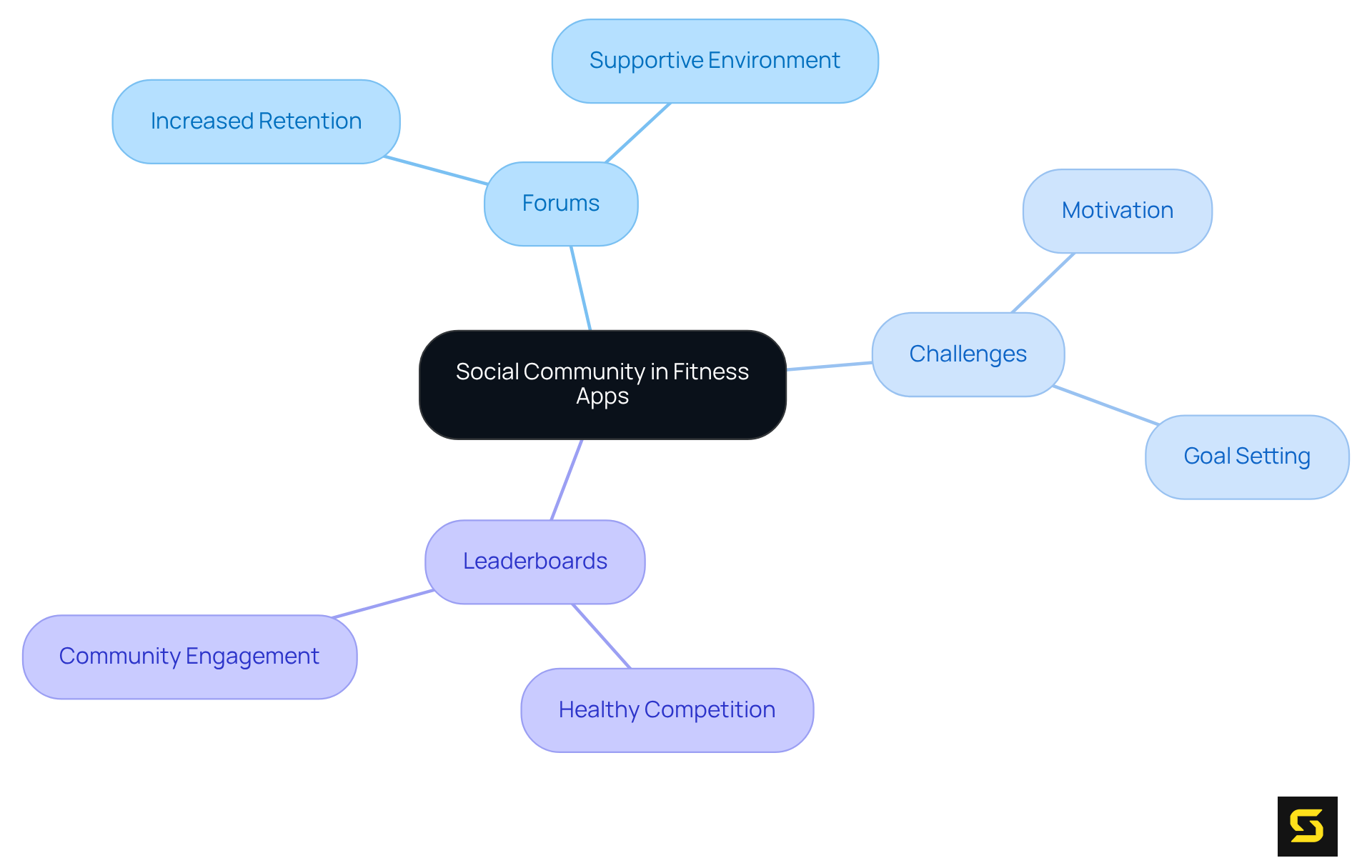
Wearable Integration: Tracking Fitness Progress
Incorporating wearable technology into fitness app development empowers individuals to track their progress in real-time, providing essential insights into their workouts and overall well-being. By seamlessly connecting with devices such as smartwatches and activity monitors, these applications gather critical information on heart rate, steps taken, and calories burned, providing individuals with a comprehensive view of their wellness journey. Notably, 25% of U.S. adults own a smartwatch or activity tracker, underscoring the widespread acceptance of wearable technology. This smooth integration not only enhances the user experience but also enables developers involved in fitness app development to tailor suggestions based on real-time data, thereby improving workout effectiveness and aligning with personal wellness goals.
Moreover, real-time data from wearables allows healthcare providers to adjust treatment plans effectively, highlighting the broader implications of wearable technology in health management. With the wearable device market projected to reach $265 billion by 2030, the demand for personalized and engaging wellness solutions continues to rise, making fitness app development imperative for developers to prioritize these features in their applications. As industry specialists assert, "Digital health solutions and wearable integration are shaping the future of healthcare," reinforcing the significance of these advancements.
![]()
Regular Content Updates: Keeping Users Engaged
Frequent content updates are vital for sustaining engagement in fitness app development. By consistently introducing new workouts, challenges, and educational resources, fitness app development cultivates a dynamic environment that compels individuals to return. Seasonal themes and popular exercise challenges not only draw participants but also encourage them to explore diverse workout regimens and methods.
Research shows that customer retention can surge by 50% through seamless onboarding and engaging content, while acquiring new customers can be at least five times more costly than retaining existing ones. Furthermore, health applications that regularly refresh their services significantly enhance customer satisfaction; 68% of consumers are willing to pay more for companies that provide exceptional client support. This perceived support is bolstered by continuous updates that keep individuals engaged and satisfied.
Additionally, the growing trend of fitness app development integrated into corporate health initiatives by 2025 underscores the broader market factors influencing participant engagement. This strategy ensures that the app remains an indispensable tool in individuals' wellness journeys, fostering a sense of community and commitment to their health goals.
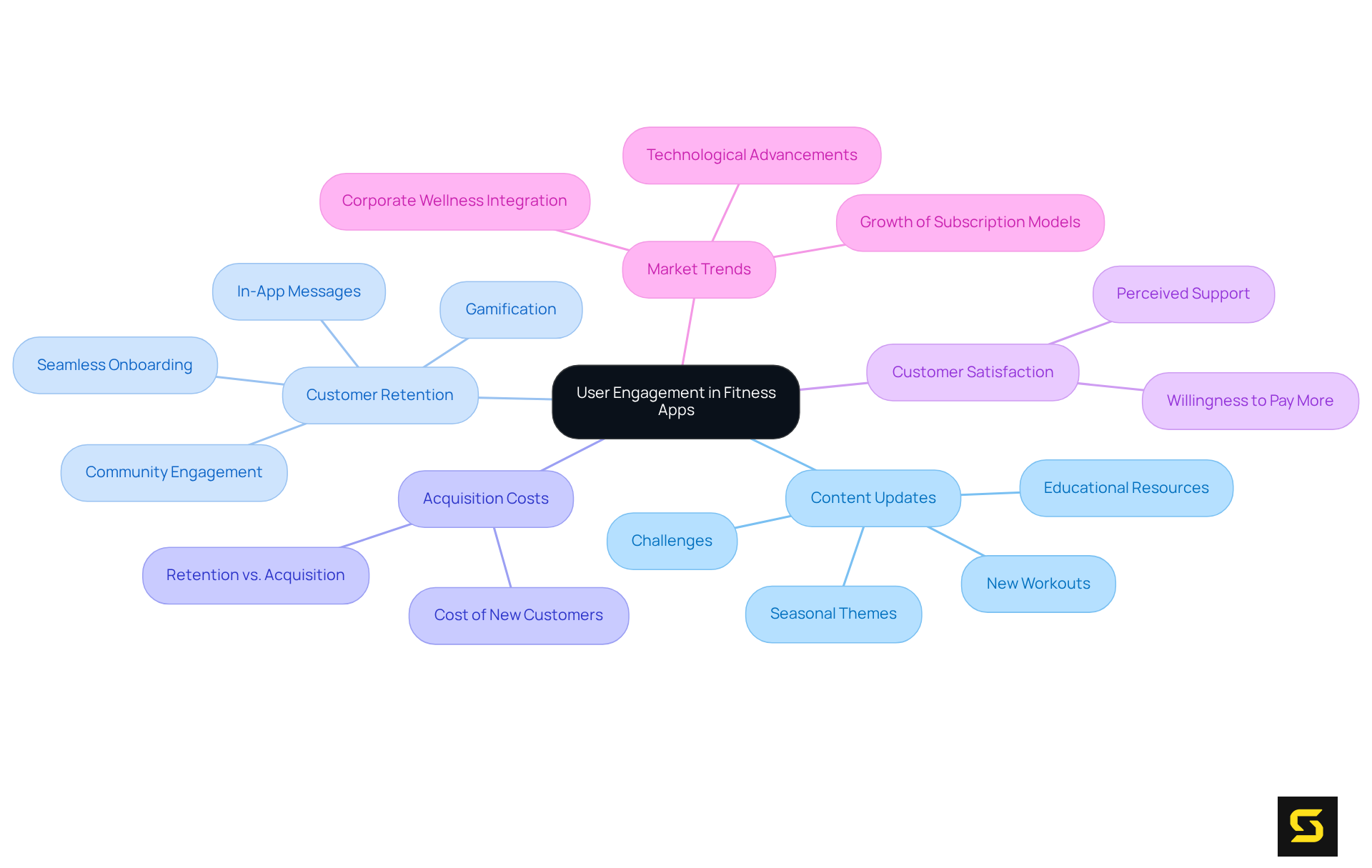
Gamification: Motivating Users Through Challenges
Gamification is a powerful strategy in fitness app development that integrates game-like elements into fitness applications, significantly enhancing motivation and engagement. Features such as points, badges, and challenges not only foster a sense of accomplishment but also stimulate healthy rivalry among participants.
Through fitness app development, establishing leaderboards and offering incentives for completing workouts or achieving milestones effectively motivates individuals to stay active and involved. This approach not only elevates the enjoyment of physical activity but also cultivates a vibrant community, where individuals can share their achievements and compete with friends.
Embrace gamification in your fitness journey to unlock your potential and experience the benefits of active participation.
User Feedback: Driving Continuous Improvement
In 2025, the collection and integration of feedback from individuals is paramount for the continuous enhancement of fitness applications. By actively soliciting feedback through surveys, reviews, and in-app response mechanisms, developers gain critical insights into effective features and areas requiring improvement. This iterative process not only boosts app functionality but also signals to participants that their feedback is valued, thus fostering loyalty and encouraging sustained engagement.
For example, fitness applications that have embraced participant suggestions—such as those enabling users to monitor calories and receive tailored meal ideas—have reported substantial increases in satisfaction rates. Research demonstrates that apps responsive to feedback can elevate retention rates by as much as 30%.
Furthermore, with 50% of individuals refraining from exercise due to a lack of enjoyment, regular updates informed by participant feedback can significantly enhance the overall experience and cultivate a sense of community among users, reinforcing their commitment to the app and its offerings. By prioritizing user opinions, developers can ensure that their fitness app development remains relevant and effective in addressing the evolving needs of their audience.
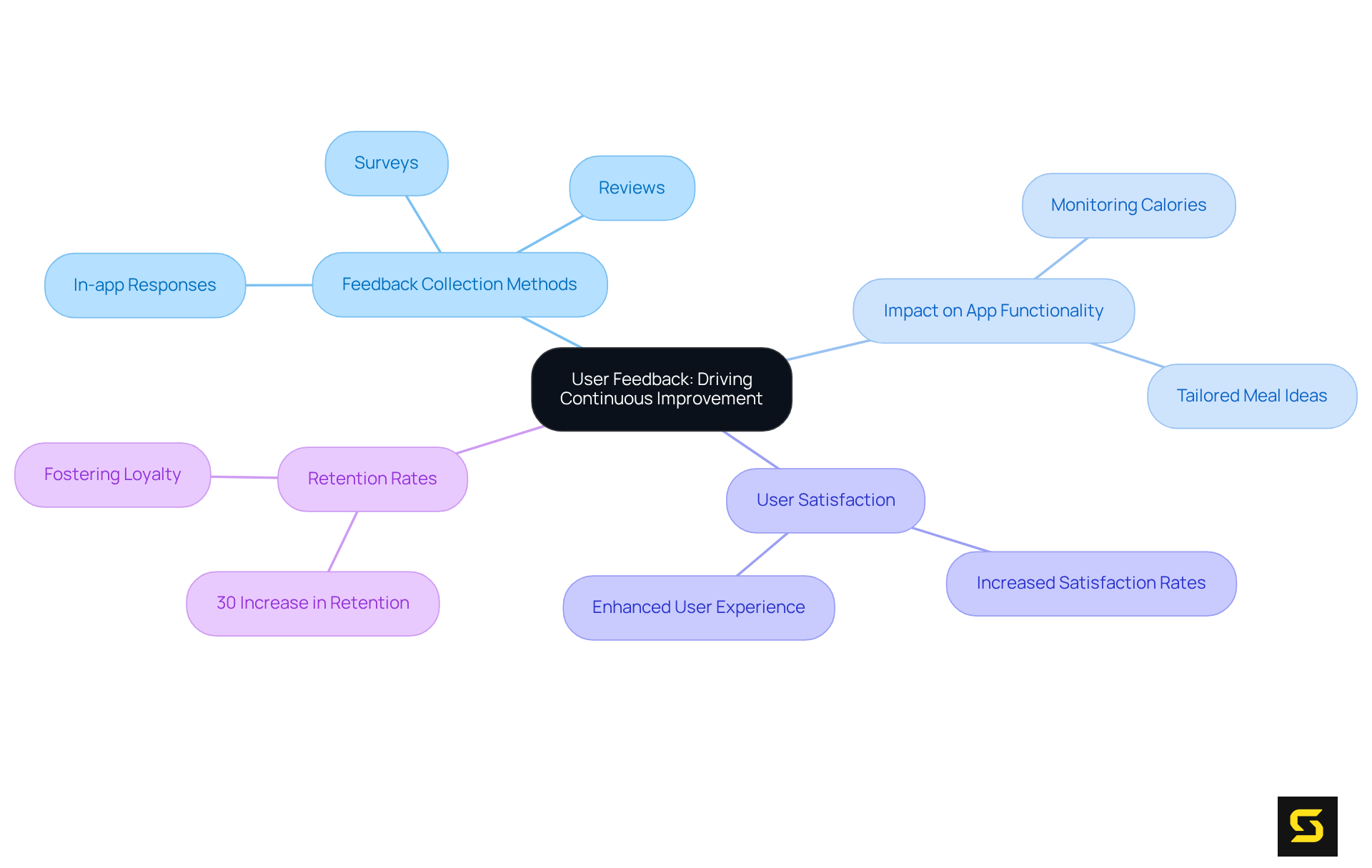
Conclusion
The development of successful fitness applications is fundamentally rooted in a blend of innovative features and user-centric design. With the fitness app market on the brink of substantial growth, comprehending the essential components—such as personalized workouts, analytics integration, and robust data security—becomes imperative for developers who aspire to create engaging and effective solutions. By prioritizing the unique needs of users, app creators can cultivate an environment that fosters health and wellness, ultimately leading to elevated retention rates and enhanced user satisfaction.
Throughout this article, critical insights have been discussed, underscoring the significance of tailored experiences through AI-driven recommendations, the impact of community engagement in bolstering motivation, and the necessity of intuitive UI design for usability. Furthermore, the integration of wearable technology and regular content updates have been identified as pivotal strategies for maintaining user engagement and investment in their fitness journeys. Each of these elements contributes to a holistic approach to fitness app development that not only addresses current market demands but also anticipates future trends.
As the landscape of fitness technology continues to evolve, it is essential for developers to embrace these vital features and remain responsive to user feedback. By doing so, they can craft applications that not only support individual health goals but also cultivate a loyal user base. The future of fitness app development hinges on the capacity to innovate while maintaining a steadfast focus on user experience—an endeavor that promises to revolutionize how individuals engage with their health and wellness.
Frequently Asked Questions
What is SDA and what services do they provide?
SDA specializes in custom software development tailored for the sports industry, particularly fitness app creators. They focus on client-centered design to create engaging applications that enhance health and wellness.
What is the projected growth of the fitness app development market?
The fitness app development market is projected to reach USD 25.9 billion by 2025, driven by increased health consciousness and technological advancements.
What challenges do wellness application creators face?
Creators of wellness applications encounter challenges such as navigating stricter regulatory environments, addressing privacy concerns, and selecting the appropriate tech stack, which impacts development costs and app capabilities.
What features are important for successful fitness app development?
Successful fitness app development often includes personalized workout plans, gamification elements, and real-time data monitoring through wearable devices, which enhance participant engagement.
How does personalization enhance fitness app user experience?
Personalization, achieved through tailored exercise routines and AI-driven recommendations, increases user satisfaction and engagement by addressing individual needs and preferences, leading to improved retention rates.
What role does AI play in fitness app development?
AI enhances personalization by evaluating individual performance and preferences, allowing for optimal exercise recommendations that align with users' evolving wellness objectives.
How does analytics integration benefit fitness app development?
Analytics integration allows developers to track participant behavior and engagement levels, revealing trends and areas for improvement, which enhances user experience and satisfaction.
What is the significance of data-driven strategies in fitness app development?
Data-driven strategies are crucial for maintaining competitiveness in the fitness app market, as they help developers address the evolving demands of health enthusiasts and foster user loyalty through tangible results.
What is the projected growth of the digital wellness market?
The digital wellness market is projected to reach $89.32 billion by 2030, highlighting the importance of innovative fitness app development strategies.





